Explaining the URWERK EMC Time Hunter – Review (live pics, specs & price)
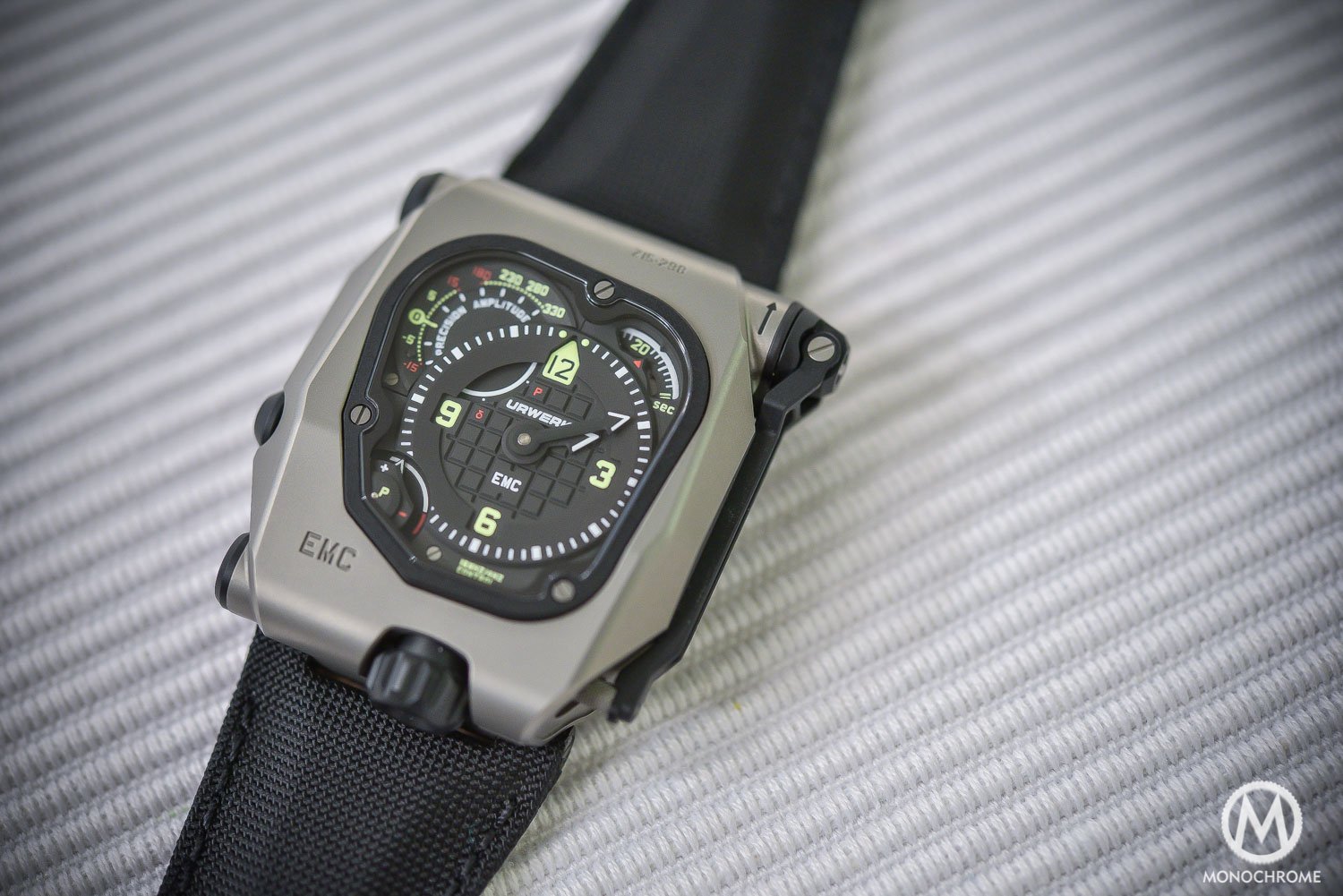
When talking about URWERK, we immediately have in mind bold, mechanical watches with a unusual display composed of satellites and jumping hands. It’s a brand that has to be experienced to be fully understood. Watches at URWERK are not made for a large audience, not only because of their high prices, but because their design and display are just out of this world. However, URWERK is not only about this. There’s something more, much more innovative: self-monitoring and self-adjusting of your mechanical movement. It’s what the URWERK EMC Time Hunter does and it is revolutionary. Come with us to understand how this innovation is possible.
The URWERK EMC Time Hunter is part of a rare category of watches: hybrids. Just like a hybrid car, it mixes electricity and mechanics to make it much more user friendly (but unlike a hybrid car, the URWERK EMC Time Hunter won’t help ecology…). Just like a hybrid car, a hybrid watch uses the benefits of electricity or electronic to make the technical parts more accurate, more precise and more reliable. There are few examples of such technology. The most famous one is of course the Seiko Spring Drive technology, that mixes an automatic winding, a classical mainspring and an absolutely normal gear train to a quartz regulator in place of a classical beating regulator, composed of parts like a balance wheel, a hairspring, an escape wheel and a pallet fork – highly old-school, potentially fragile and hard to adjust parts (based on a 3-century old technology…). Instead of this traditional beating heart, the hybrid watches rely on a quartz regulator but all the rest is mechanical. Why? In order to keep the beauty of a mechanical movement with the precision of quartz. For some, the best of both worlds, just like hybrid cars.
However, the URWERK EMC Time Hunter is a tiny bit different… to say the least. If the Seiko Spring Drive can be compared to a Toyota Prius (efficient, user and planet friendly, economical and reliable… and also quite boring), the hybrid technology at URWERK is a bit in the vein of the one in a LaFerrari or a McLaren P1. The Prius is based on efficiency. The McLaren and the Ferrari aim to even enhance the pleasure. Just like a LaFerrari, the URWERK is built around a mechanical engine with electronic parts around it, just to create an even greater experience. Unlike a Seiko, the EMC Time Hunter still relies on a fully mechanical movement, with classical regulator. The electronic parts aren’t in the center of the show. They aren’t here to make your watch more accurate. They are here to HELP YOU making your watch more accurate. And it makes a world of difference. A Prius uses electricity to be more ecological. A LaFerrari uses electricity for even more power and fun. Same at URWERK.
What does the URWERK EMC Time Hunter?
Before anything else, the URWERK EMC Time Hunter is a watch, meaning that it tells time, with the hours, the minutes (in the central dial) and the seconds (in the top right corner). It also includes a power reserve indicator (in the bottom left corner of the dial). Nothing exceptional you’ll admit. Well, in fact there another sub-dial on this watch, positioned in the top left corner, with two scales and very unusual inscriptions: precision and amplitude. Of course, these are words that watch enthusiasts are used to hear in watch-focused conversations, or to read in watch-related specification sheets. However, it is less common to see these words on a dial. This is where the URWERK EMC Time Hunter begins to be properly interesting and unique.
In fact, this is not the first attempt by URWERK down such a path. In 2013, the brand introduced the EMC (first edition), these three letters referring to Electro Mechanical Control. However, this first edition only came with the word “precision” on its dial. With the second one, we have an extra “amplitude” feature. Why these indications? In fact, as we said in the introduction, the URWERK EMC Time Hunter uses hybrid technology not to make the watch more accurate but to help the user making his mechanical watch perfectly accurate, by monitoring both the precision and the amplitude – and by allowing him to personally adjust the watch, easily, by himself (and not with the help of a trained watchmaker).
Before it goes to its final owner, a watch is regulated (its precision tested and adjusted) by the watchmaker. It is placed on a continually rotating arm in a fairly temperature-stable room. The rotating arm ensures that the watch spends fairly equal time all positions. But the timing of a mechanical watch changes slightly in each position as well as with changes in temperature. So in the real world of a watch on the wrist, how long it spends in each position (on average) will depend on the wearer’s activities. Thus, two different people wearing the same watch for a week will find that its accuracy differs.
What is so unique in this watch and what it does? First of all, via a monitoring system, the URWERK EMC Time Hunter enables the wearer to note how many seconds the watch gains or loses in a day (understand here the “precision”). Then, via a screw in the case back, the EMC can be adjusted depending on the results you obtain (the precision of the movement can then be simply adjusted faster or slower by turning the screw on the back of the watch). Finally, it allows testing that precision using the EMC function to confirm that the adjustment is correct.
Then, and this is the novelty on the EMC Time Hunter, the monitoring mechanism can also control amplitude. Amplitude is how far in degrees the pendulum or the balance wheel moves through each oscillation. In practice, the balance in most wristwatch movements should oscillate with an amplitude of between 220° and 280° for maximum efficiency. Because the tiny balance wheel has relatively low mass and oscillates so quickly (back and forth four times each second), the slightest degradation in the lubricating oil of the balance staff manifests in lower amplitude. Thus, balance amplitude is a good indicator for a movement being “healthy” or needing service. With the EMC Time Hunter, you can thus monitor (and only monitor, as no adjustment operations are possible here) if your watch is running good or not.
What’s inside the URWERK EMC Time Hunter?
Behind this complex description hide 2 main parts: a mechanical movement and an electronic brain. Of course, the central point (and certainly the strangest part of the watch) remains the screw for fine tuning on top of the movement. The innovative idea of the UWERK EMC was to incorporate a Witschi-like measuring instrument in a mechanical watch and then to have the ability to adjust the watch by simply turning a screw – something that even normal people, non-trained watchmakers, could easily do at home. At its heart, the EMC has a triple objective: to show how external parameters (positional changes, temperature, and pressure) influence the timing of the movement; to enable the wearer to adjust the timing and to facilitate interactivity between the timepiece and its owner.
The EMC Time Hunter is composed of several parts. First of all, there is a mechanical movement, entirely developed and assembled by URWERK. Its chronometric performance is tested in five positions during a 30-day cycle to ensure that it meets the highest standards for a precision watch. It features:
- A bespoke balance wheel made of ARCAP, an antimagnetic alloy. It shows a highly unusual linear shape, to optimize aerodynamic efficiency, to minimize loss of amplitude and mainly to facilitate calculations from the optical sensor.
- A double vertical barrel, easily visible from the back of the watch, positioned next to the crown and providing an 80 hours power reserve to the movement.
- Classical haute horlogerie finish, with Côtes de Genève, snailing, micro-bead blasting, polished bevels on screw heads.
- The timing adjustment screw, accessible on the back of the watch.
Then, as said before, the EMC Time Hunter is able to monitor and evaluate its mechanical movement, giving indications of the precision and the amplitude. In fact, an optical sensor is positioned on top of the balance wheel. This sensor captures the precise rate of oscillation of the 4 hertz / 28,800vph regulator, over a period of 3 seconds. This sensor consists of a transmitter and a receiver positioned either side of the balance.
Then comes the comparative device. Not only the URWERK EMC captures the rate of the watch but it also gives an indication of the deviation (-/+ x seconds per day). However, in order to bring such indication, the watch needs a reference point. Thus, it features a Quartz Oscillator, beating at 16,000,000 hertz. The performance of the balance of EMC (4 Hz) is compared against this lightning-fast oscillator to obtain the most accurate measurement possible. Side Note: this quartz oscillator has nothing to do with time keeping. It has no influence on the precision of the watch and no influence on the gear train or the hands. It is here only for comparison matters.
The URWERK EMC Time Hunter features an electronic brain, a “miniaturized computer” that determines the difference between the timing rate of the movement and that of the reference oscillator. Each micro-second difference between the two values is expressed as a gain or loss of a second per day of the timing rate. A variation of just 0.0000014 of a second per half-vibration translates as a variation of a second per day. This micro computer is located on the right side of the movement, next to the barrels, under a protective grill.
Finally, there’s a manual-winding generator, which brings energy to the EMC’s monitoring unit (the optical sensor and the computer). This micro-generator is made by the Swiss company Maxon, which is well known for developing motors for NASA’s Mars rovers.
How does this monitoring / adjusting operation works?
The first thing to do when the wearer wants to monitor and adjust his URWERK EMC Time Hunter is to bring power to the monitoring unit, by winding the fold-out crank handle, positioned on the right side of the watch. After winding and pressing a button positioned on the left side of the watch, the hand of the sub-dial on the top left corner will first indicate either δ (processing underway) or P (not enough power, which means you need to wind again the crank handle) – in the lower part of the dial. The EMC hand will then indicate the movement’s precision to +/- 15 seconds per day for a few seconds, followed by the amplitude of the balance, the latter being a good indicator of the health of a movement and if it requires servicing.
As well as these two indications, a LED on the precision display between -5 and -15 seconds will shine either green for “all okay,” or red if one or both of the EMC indications fall outside acceptable parameters. If the result isn’t good enough, the precision of the movement can then be simply adjusted faster or slower by turning the screw on the back of the watch. This allows the user to adjust the time, to suit their own lifestyle. Once adjusted, simply do another monitoring process, to be sure that the adjustments you’ve done are the right ones.
Basically, the operation and the use are extremely simple, even if the process behind is from an extreme complexity. The URWERK EMC Time Hunter is something unique: it allows an astonishing interactivity between the watch and its wearer, it allows the wearer to self-adjust the watch to its lifestyle, to the place he lives, to the positions he usually has when wearing the watch. It is not the first time that watchmakers tend to perfectly adjust watches to the wearer. However, it is the first time that the wearer can adjust the watch, easily, without any watchmaking knowledge, to his own way of wearing a watch. It is simply brilliant.
The URWERK EMC Time Hunter on the wrist
The URWERK EMC Time Hunter isn’t just a functionality update of the older EMC. The brand also decided to update the look. This is mainly a face-lift, as the shape of case remains the same as the previous editions. While the 1st version featured 4 small sub-dials, with separated indications of the time, of the seconds, of the power reserve and of the precision, this new “Time Hunter” feels a bit more classical – and maybe a bit more friendly on the wrist too – with its large opening circling the whole 4 indications.
This new design might be seen as less bold than the previous one but on the other hand, the first EMC was maybe going too far for some. This “Time Hunter” is possibly the good blend between the DNA of URWERK (even if it is quite different from a UR-210s for example), a strong and recognizable design that is bold enough to stand out of the crowd and finally a decent daily wearability and legibility of the indications. Of course, considering its unique shape, the special strap attachment system and the overall look – almost military, highly toolish – this watch isn’t a standard object. And clearly, this is also part of the pleasure when wearing a URWERK. Maybe it misses a bit of elegance but guess what, we love this watch here, at Monochrome-Watches.
The URWERK EMC Time Hunter exists in 2 editions (15 pieces of each will be produced), one in raw titanium and steel, with bead-blasted surfaces, a black dial with yellow indexes and a fabric black strap; one in titanium and steel, coated with military green ceramic and mounted on a fabric black strap (we had it here on a Tweed strap, like the UR-110 Eastwood). Deliveries just started. The price is 110,000 Swiss Francs (before taxes) for the titanium edition and 115,000 Swiss Francs (before taxes) for the military green coated edition.
To conclude this test of the URWERK EMC Time Hunter, there’s one thing that we want you to be aware of: this watch is simply unique. No other timing devices allow such interaction with its wearer, such ability to monitor its precision and such possibility to adjust the precision. The overall idea is brilliant and the execution, considering the amount of technology deployed, is astonishing. The best comes from the ease of use… It is almost as simple as using a smartphone. Some will say that the design is strange or that this concept is somehow useless. We let them say and instead enjoy such innovative ideas.
You can read more details about this watch on the dedicated page on the official website or URWERK.


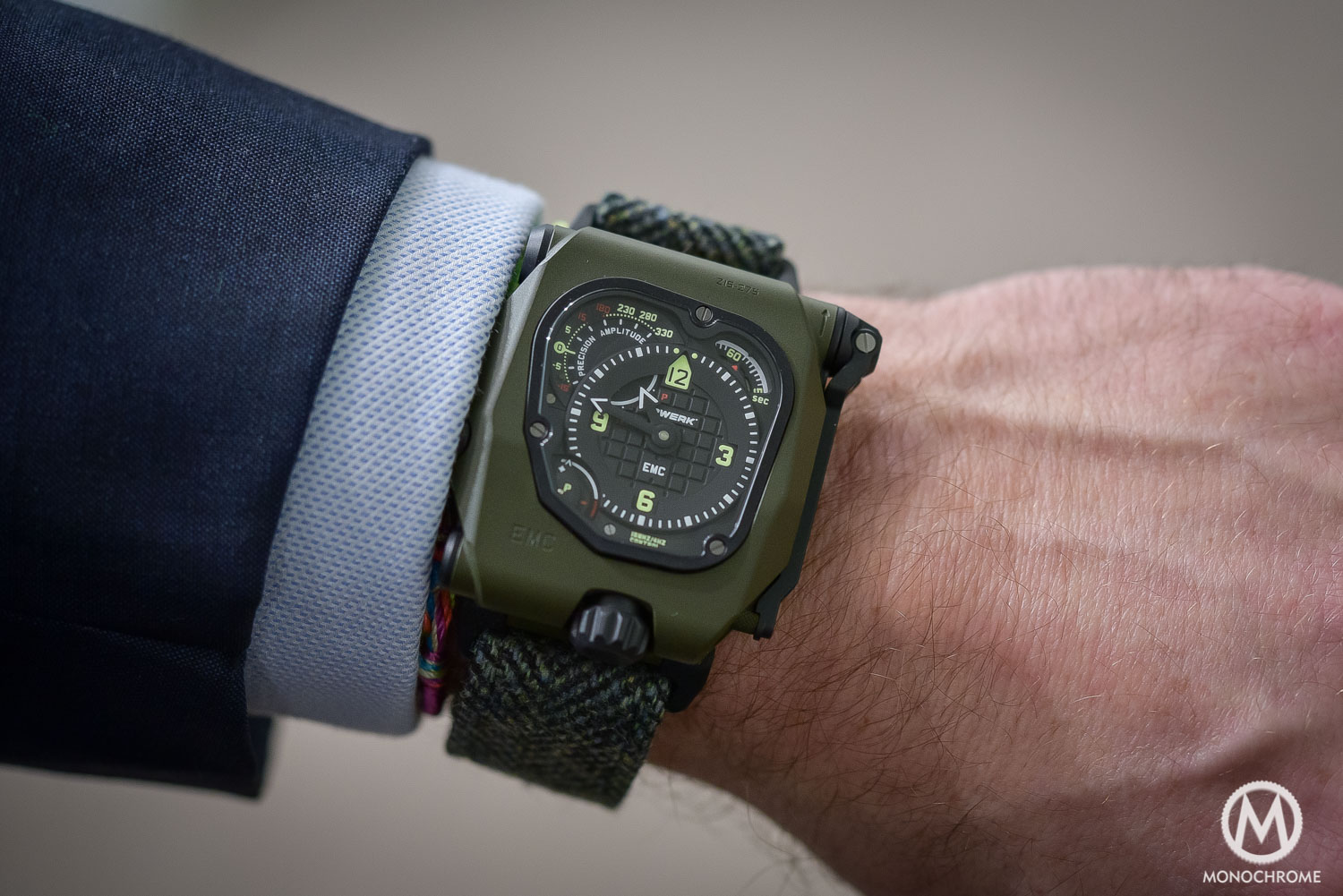
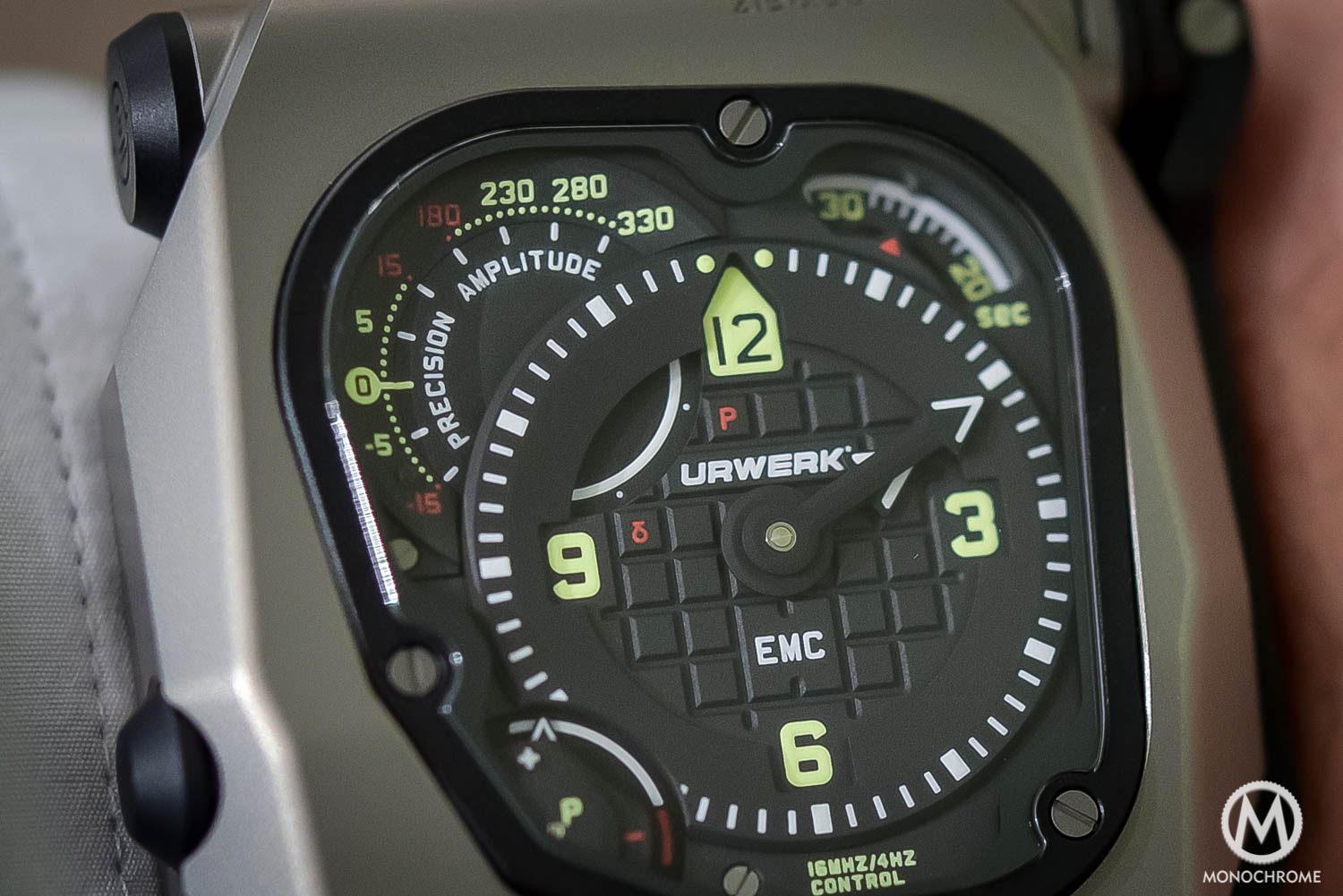
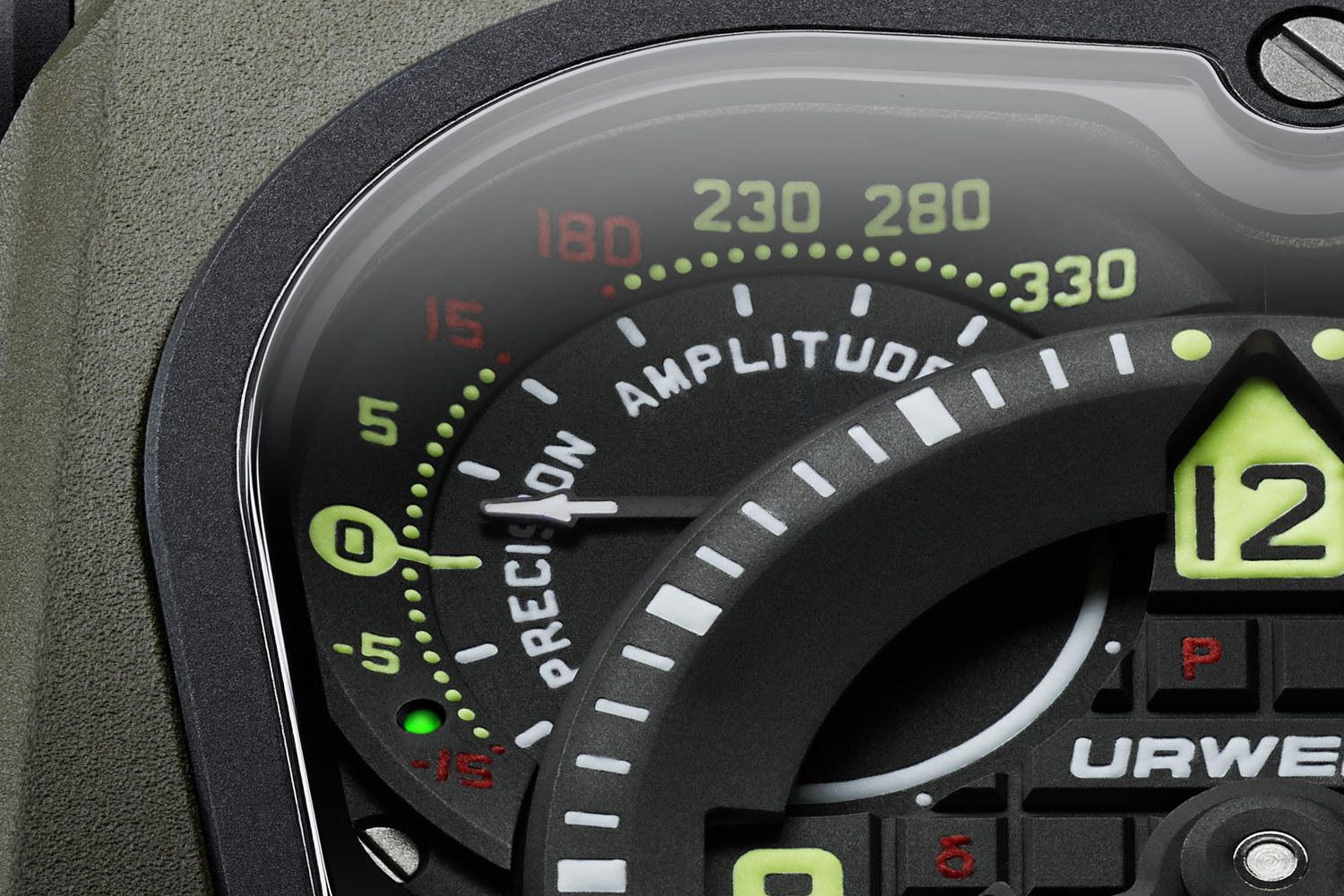
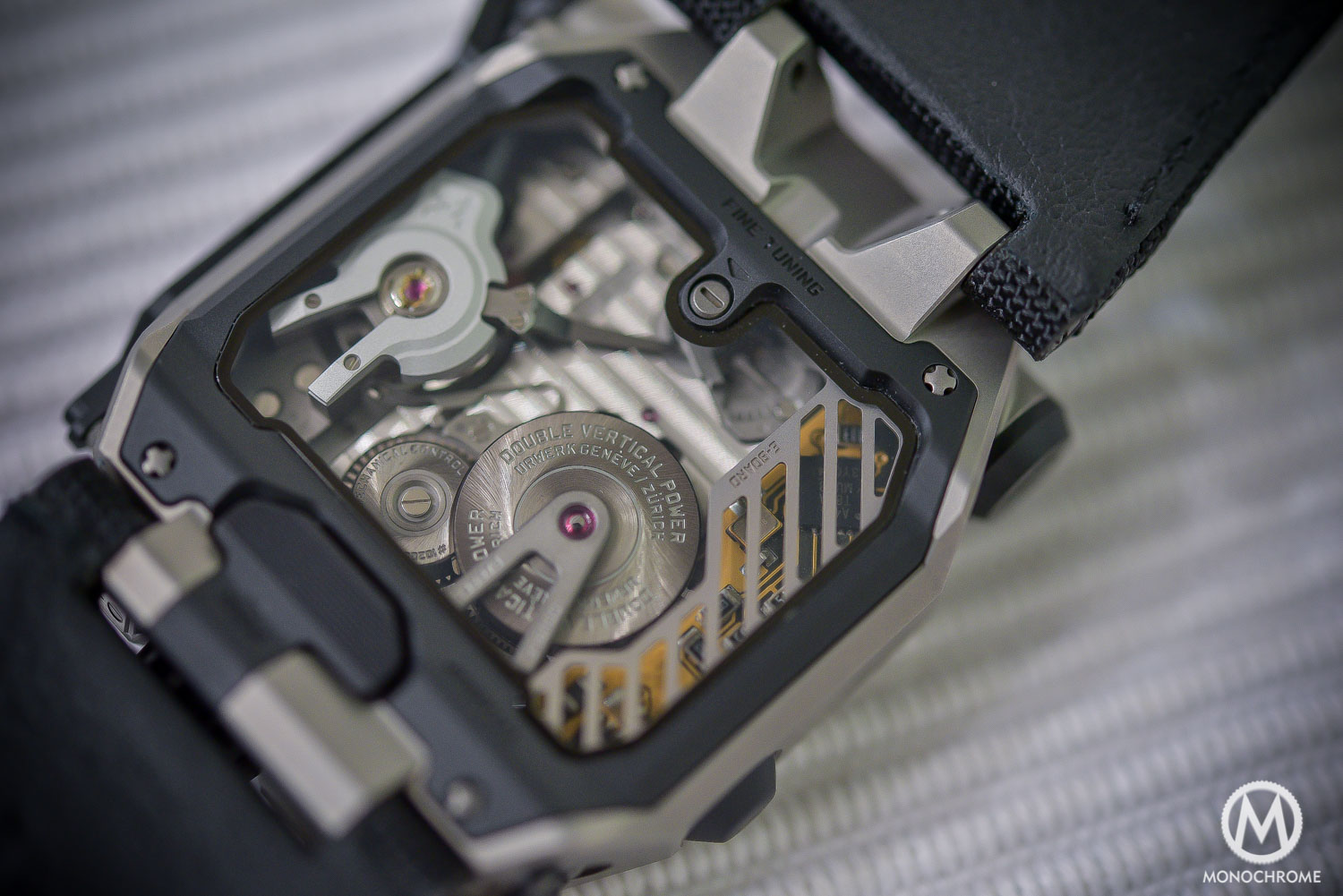

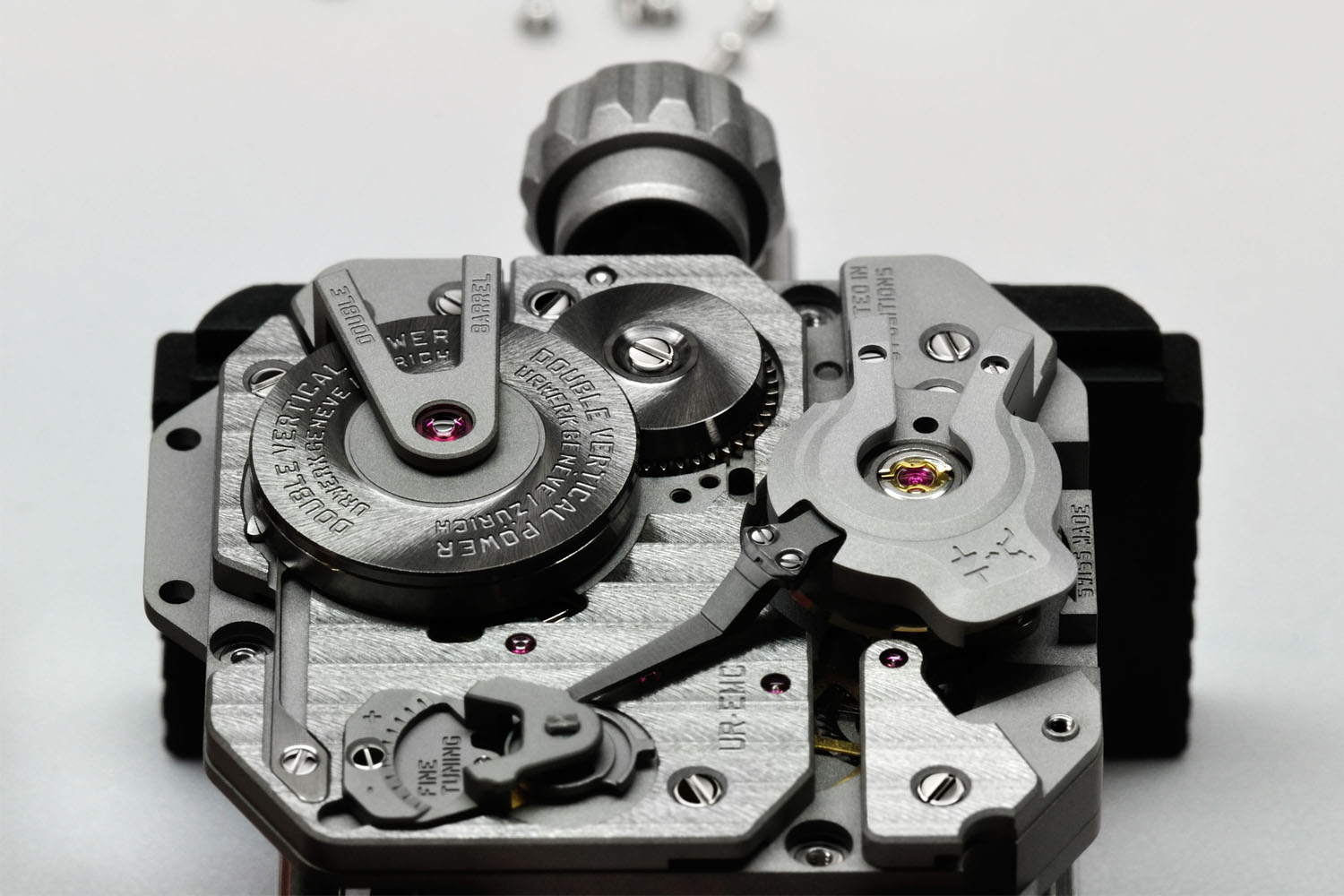
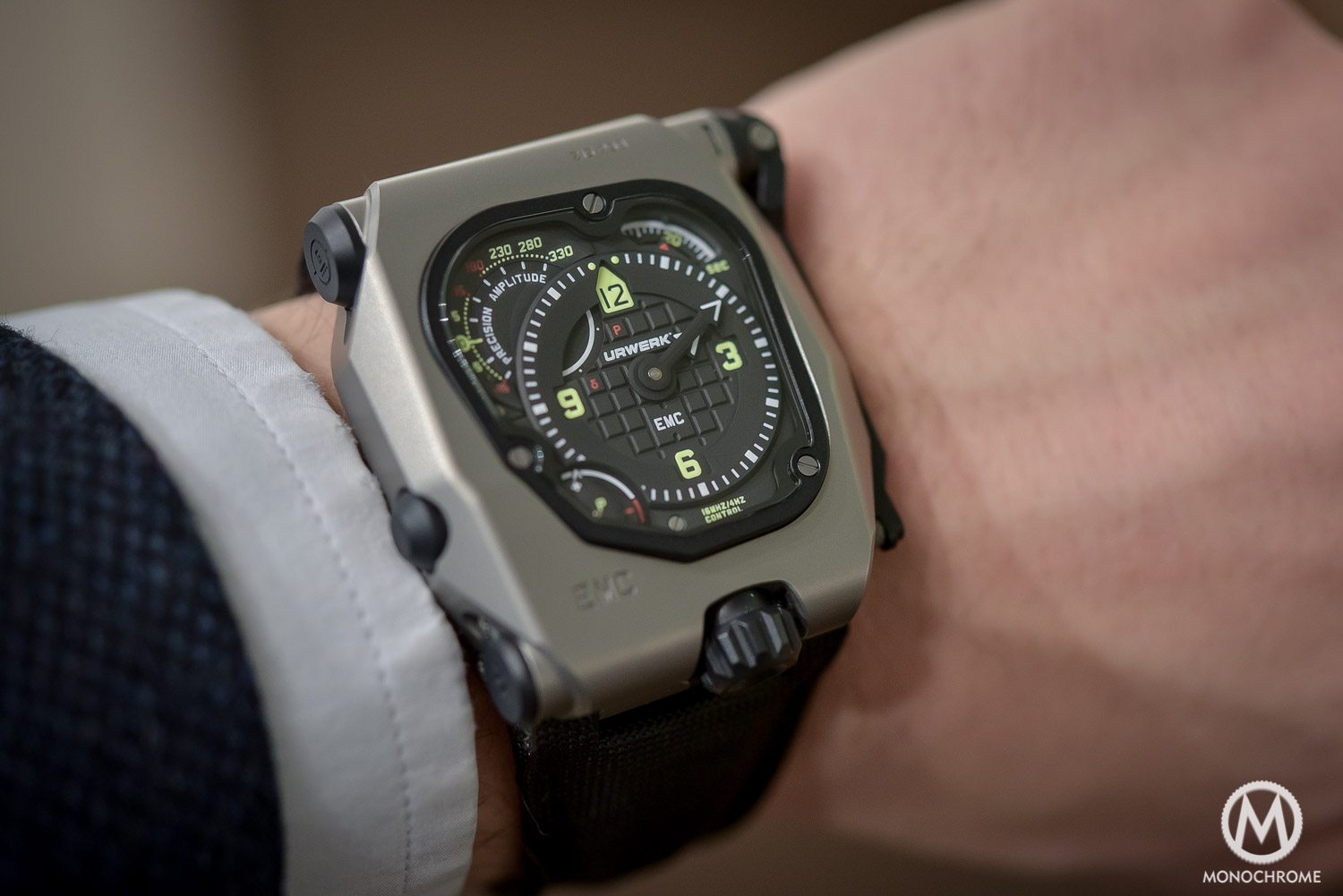
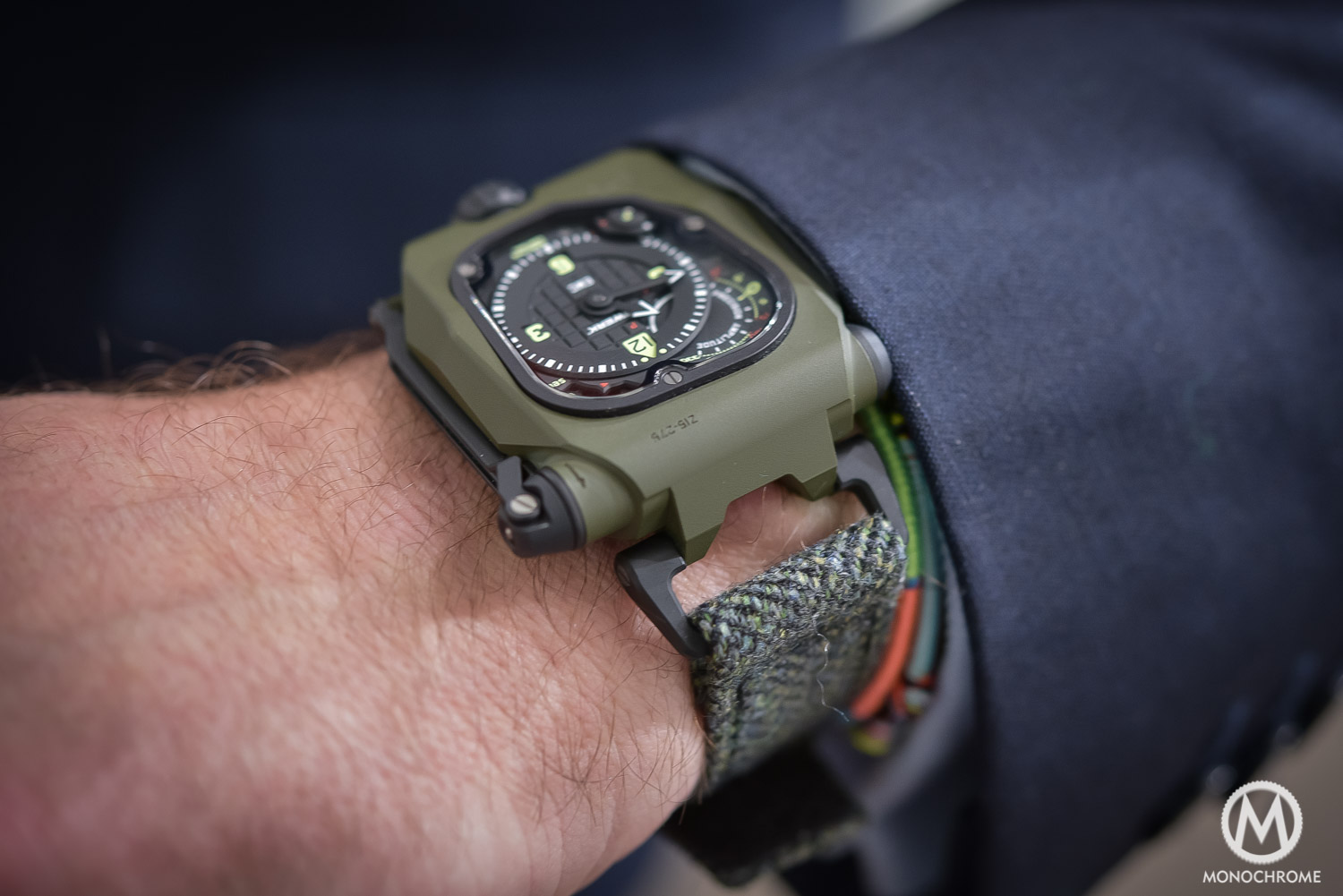
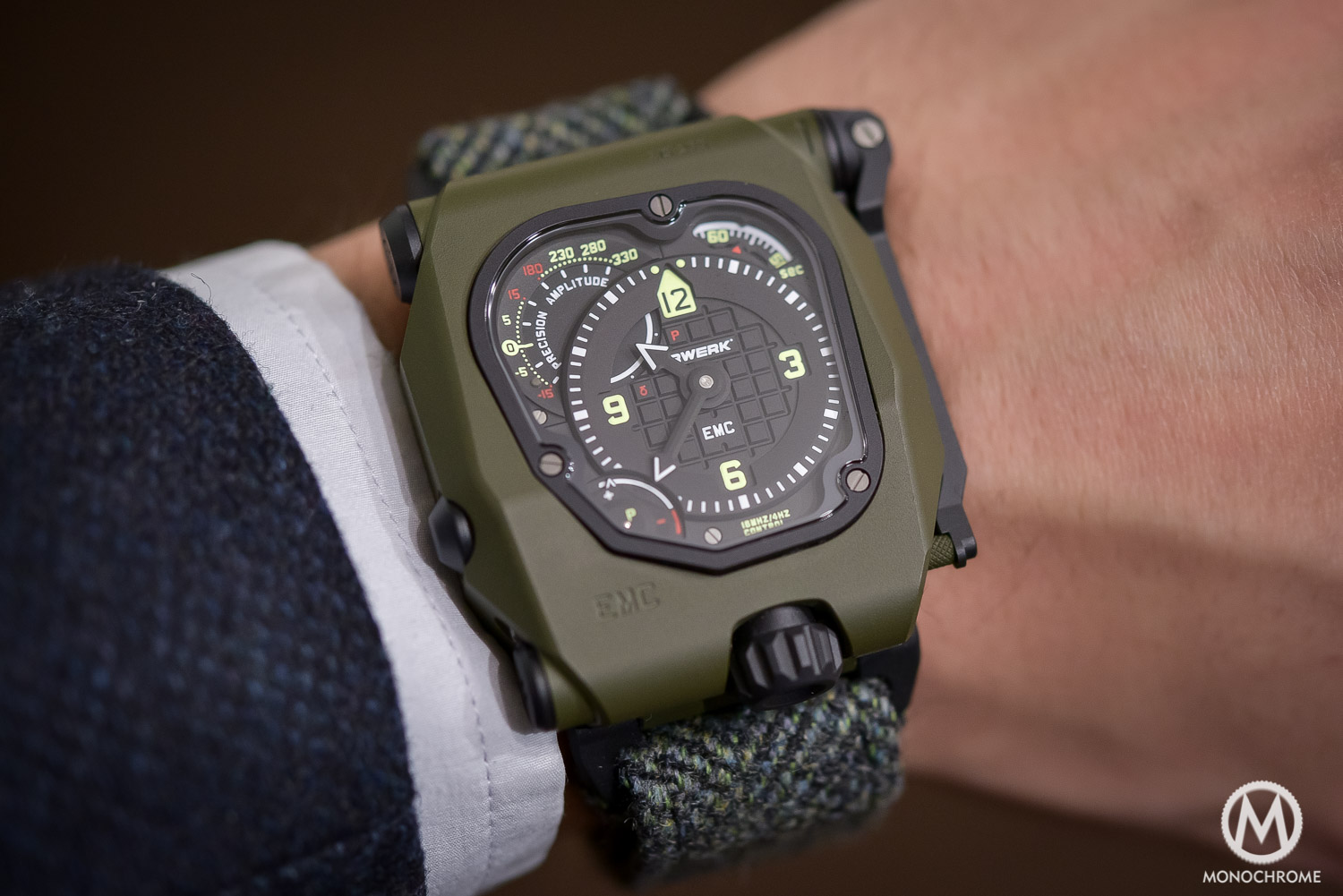



3 responses
Being a 100% mechanical watch it can only be as accurate as a good mechanical watch. The possibility of influencing/controlling this accuracy as a built-in feature by yourself is a curious complication. The 16mm high watch does not appeal to me at all: it’s downright ugly.
Brilliant. A technophiles dream come true.
A hacking seconds function very quickly points to an obvious need for adjustment on your watch.
Waiting for a company like Seiko to bring this functionality to the masses.
No reason why even an ordinary classically designed watch can’t incorporate these features at a fraction of the cost.
A tiny solar cell hidden on the dial can easily provide the power. The back of the watch can display the measurements on an lcd.
One step further…a small plug on side of case can link to an app on your phone to perform the Precission and amplitude evaluation.
No need to carry the power supply, computer chip. Just the optical reader, and screw adjustment need be in the watch case.